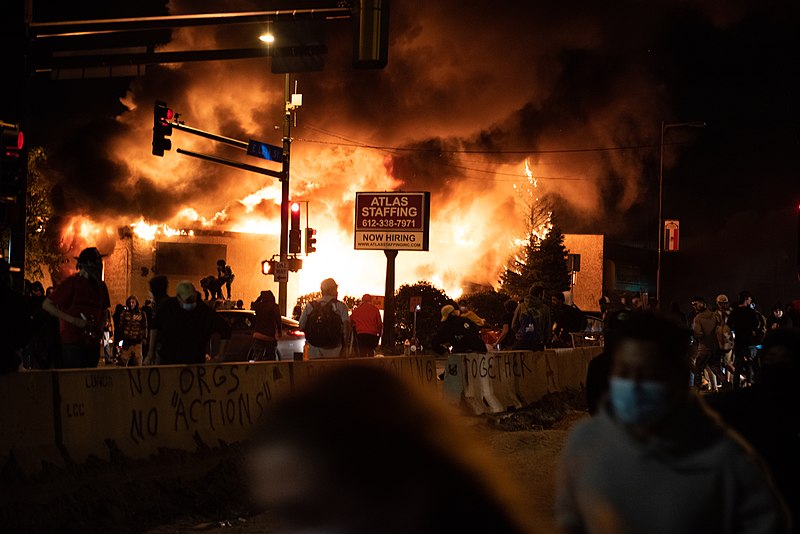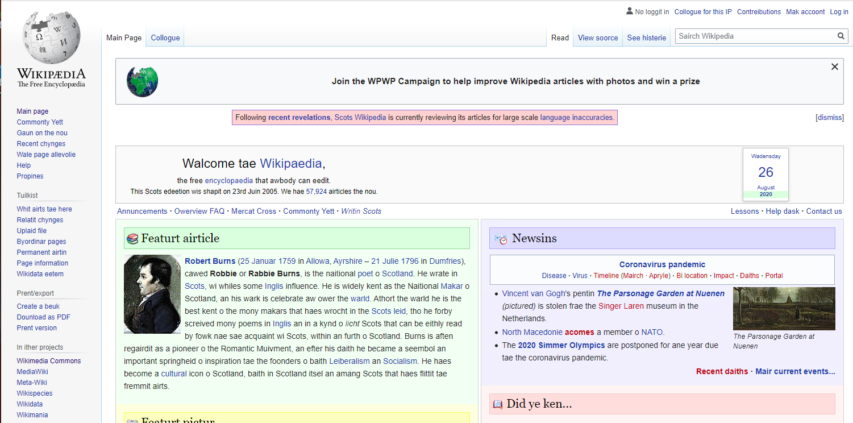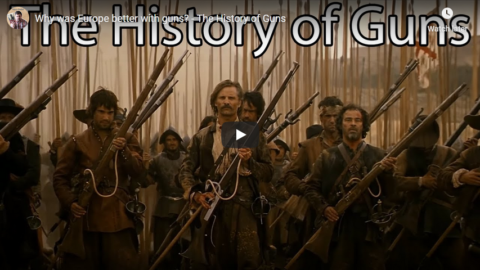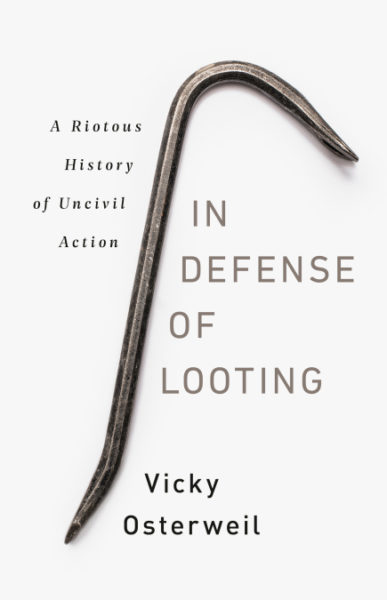Invicta
Published 19 Apr 2018Today we dive into the world of Early Medieval England to analyze the military equipment available to the warring Anglo Saxons and Vikings!
Support future documentaries: https://www.patreon.com/InvictaHistory
Twitter: https://twitter.com/InvictaHistoryDocumentary Credits:
Research: Invicta
Script: Invicta
Artwork: Osprey Publishing
Game: Total War Saga: Thrones of Britannia
Editing: Invicta
Music: Total War: Attila and Total War Battles: Kingdoms SoundtrackLiterary Sources
–Anglo-Saxon Thegn by Mark Harrison (Osprey Publishing)
–Viking Hersir 793–1066 AD by Mark Harrison (Osprey Publishing)
–Saxon, Viking and Norman by Terence Wise (Osprey Publishing)
August 31, 2020
Military Equipment of the Anglo Saxons and Vikings
“The ‘Scots’ that wis uised in this airticle wis written bi a body that’s mither tongue isna Scots. Please impruive this airticle gin ye can.”
Natalie Solent has some sympathy for the recently revealed teen who is the main “author” of the Scots version of Wikipedia:
If you are wondering how a nineteen year old managed to be responsible for creating or editing tens of thousands of articles, the answer is simple:
He wrote: “I was only a 12-year-old kid when I started, and sometimes when you start something young, you can’t see that the habit you’ve developed is unhealthy and unhelpful as you get older.”
Naming no names except my own, that sounds like a few of us here. Ten edits a day, most days, for two and a half thousand days. The work of half his life. The thing that made him special. And now they revile him for it. Believe me, I am not laughing when I call this a sad story.
Believe me, too, when I say I do not want to mock Scots. The Samizdata “Languages” category includes many other posts by me about endangered tongues. I want them to survive and grow. A world where everyone spoke only one language would be a grey place, and one more likely to fall to tyranny. For many a soul living under oppression their knowledge of something other than the majority language has been the one window to freer times or places that the censors could not brick up. Less portentously, I like the vigorous style of Scots. The fact that it is mostly mutually intelligible with English English has been the source of endless arguments about whether it is a dialect of English or a language in its own right. It is a pity that this question has been politicised. My own opinion, for what it is worth, is that although Scots was a separate language in the Middle Ages, enough linguistic convergence has occurred to say that nowadays it is a dialect of English. There is nothing wrong with that. It would be equally valid to say Standard English and Scots are both dialects on the continuum of English (and that the group as a whole is called “English” is just a matter of historically familiar terminology, not an attribution of superiority. Brits should remember that if numbers of speakers were the criterion that decided the name of this language we would be speaking American.)
It is a sad reflection on the state of Scots that nobody stopped “AmaryllisGardner” for five years. Scarcely anyone seems to have questioned him. I cannot help thinking this fiasco would never have happened if linguists and the penumbra of people who are “into” languages had not been so down on prescriptivism. After all, if there truly is no correct or incorrect way to use language, our laddie’s version of Scots has as much claim to be right as the one they speak in Glasgow.
Why was Europe better with guns? – The History of Guns
History Clarified
Published 3 Dec 2018China invented gunpowder (combustible powder), so why was it the European nations that went out and conquered the world using firearms?
This video looks at some geographical factors to examine what allowed Europe to innovate while China and most of the world fell behind with gunpowder weapons.
This focuses heavily on Kenneth Chase’s Book, Firearms: A Global History to 1700. He tries to get away from just looking at drill, organization, and state production of firearms to see how geography helped create the necessary conditions for those other innovations.
Interested in your own copy? Check out the link below:
DISCLAIMER: This video description contains affiliate links, which means that if you click on one of the product links below, I’ll receive a small commission.
The map of Japan is under Creative Commons 4.0.
Michelle Remembers, the seminal Satanic Panic book
Jen Gerson discusses the first modern Satanic Panic and the book about the “recovered” childhood memories of a British Columbia woman in the 1970s:
QAnon may sound like something that could only have birthed in the darker corners of the internet. But QAnon predates president Donald Trump and even the internet itself; It’s just the latest iteration of a moral panic that swept the highest levels of Western society only a generation ago. One of the most polarizing and divisive social movements in modern history; it destroyed families, turned communities against one another, and sent numerous innocent men and women to prison.
And it all started in Victoria, BC.
It was known as the Satanic Panic; a conspiracy theory that convinced millions of well meaning and rational people that a secret cabal of Satanists had infiltrated the highest echelons of society in order to sexually molest children. The Satanists were accused of sacrificing animals and using women as “breeders” to create an endless supply of dead babies for use in their gory, bloody-fuelled rituals and orgies.
It destroyed lives and ripped apart families. Reports of ritualistic child abuse were reported across the English speaking-world. Almost all of them were eventually found to have been partially, or wholly fabricated, but not before dozens of innocent people were falsely accused, and sentenced to years and even decades in prison.
Born of a genuine historical injustice — society’s neglect of childhood sexual abuse — this was a panic that saw some of the world’s smartest minds taken in by accusations, that, at their root, were as preposterous as any raised during medieval European witch hunts. It was legitimized by a professional class, captivated law enforcement and proved itself a lucrative grift for fraudsters and attention seekers. Worse, as the conspiracy grew under its own weight and influence, the hysteria inspired real and horrific crimes — usually by disturbed teenagers who claimed they were sacrificing humans to Satan.
This is a case study of how badly off the rails we can go when we allow our best intentions and passions to overwhelm us.
The story begins in 1980, with the publication of a book called Michelle Remembers. It detailed the fantastic claims of Michelle Proby, who recounted several months of gory and sadistic ritualistic abuse at the hands of a cabal of Satanists when she was a child in 1950s Victoria. The memories, she alleged, were repressed for decades, until she sought help from psychiatrist Lawrence Pazder. Under a state of hypnosis, Proby began to uncover a horrifying tale of murder, torture, abduction, and molestation. She claimed to have been taken from her willing family and groomed to take part in a ritual to call the devil — one in which she witnessed the murder of children, was forced to eat human remains, covered in dead baby parts, and locked in a cage with snakes.
An explosive bestseller. Michelle Remembers would become the folkloric template for countless other claims of Satanic Ritual Abuse ostensibly uncovered during therapy during the 80s and 90s.
QotD: The Alt-right and Jordan Peterson
You can hear this in the visceral contempt with which Peterson’s “young white male” audience is described by his journalistic detractors, (most of whom are white, and many of whom are male). And yet this crucial piece of hearsay, linchpin of the Peterson narrative, is not true. It hasn’t been true for a while, if it ever was. Anyone who cares to know the truth can go out and find it: I saw it myself with my own eyes at three events I attended in the winter, as did the Maclean’s reporter who found that:
They are new Canadians, people of colour, men and women. And in a way that seems out of sync with op-ed portrayals of Peterson’s supporters as committed to preserving old hierarchies and positions of privilege — they often see themselves as searchers, truth-seekers and iconoclasts.
Popularity, even among people of color, is not, of course, proof in itself of the salubriousness of anything, especially in a world where Fox News, Breitbart, and InfoWars also command the attention of tens of millions. And indeed, Peterson really was avidly embraced at first by the far-right when he emerged, denouncing concepts of unconscious bias and white privilege, and stated his intention to defy any prospective attempt through the force of law to compel him to adopt gender-neutral pronouns in his classroom at the University of Toronto. In his rather coarse-grained and Manichaean analysis of so-called Social Justice Warriors, Peterson occasionally invoked a term, “Cultural Marxism,” whose lineage was said, by others, to have also birthed a far-right conspiracy theory that, in turn, figured prominently in the manifesto of the Norwegian mass murderer Anders Breivik. So anyone playing a game of connect the dots in order to portray Peterson as part of a recrudescence of reactionary modernism has material to work with, some of it even provided by Peterson himself.
Yet it soon enough became clear to anyone paying attention that Peterson’s initial embrace by the alt-right was a case of mistaken identity. Eventually, the spokesmen of that poisonous and amorphous internet tendency decided in concert that Peterson had been sent by the left to disrupt their “movement” and siphon off its energies by redirecting it toward an individualistic creed that would prove fatal to their own racist ethnonationalism. Peterson then rapidly crossed over to an audience that is now many multiples the size of the cohort of problematic young males who first embraced, then rejected him, even as the progressive left tried to hold on to the alt-right’s original, mistaken read.
Wesley Yang, “The Shocking Truth About Jordan Peterson”, Tablet, 2018-05-28.
August 30, 2020
Battle of Warsaw – Turning Point of Polish-Soviet War I THE GREAT WAR 1920
The Great War
Published 29 Aug 2020Sign up for Curiosity Stream and get Nebula bundled in: https://curiositystream.com/thegreatwar
In the summer of 1920 the new Poland under Josef Pilsudksi stood with their backs to Warsaw against the Red Army. The Bolsheviks had advanced in the North and in the South and some of the Soviet leadership wanted to carry the revolution into Western Europe.
» SUPPORT THE CHANNEL
Patreon: https://www.patreon.com/thegreatwar» OUR PODCAST
https://realtimehistory.net/podcast – interviews with World War 1 historians and background info for the show.» BUY OUR SOURCES IN OUR AMAZON STORES
https://realtimehistory.net/amazon *
*Buying via this link supports The Great War (Affiliate-Link)» SOURCES
Borzecki, Jerzy. The Polish-Soviet Peace of 1921 and the Creation of Interwar Europe (New Haven and London: Yale University Press, 2008)
Engelstein, Laura. Russia in Flames (Oxford University Press, 2017).
Lehnstaedt, Stephan. Der Vergessene Sieg. Der Polnisch-Sowjetische Krieg 1919-1921 und die Entstehung des modernen Osteuropa (CH Beck, 2019)
Davies, Norman. White Eagle Red Star (Random House, 2003 (1972)
Böhler, Jochen. Civil War in Central Europe, 1918-1921 (Oxford University Press, 2019)
Hux Reed, Vivian, ed. An American in Warsaw (University of Rochester Press, 2018)» MORE THE GREAT WAR
Website: https://realtimehistory.net
Instagram: https://instagram.com/the_great_war
Twitter: https://twitter.com/WW1_Series
Reddit: https://reddit.com/r/TheGreatWarChannel»CREDITS
Presented by: Jesse Alexander
Written by: Jesse Alexander
Director: Toni Steller & Florian Wittig
Director of Photography: Toni Steller
Sound: Toni Steller
Editing: Jose Gamez, Toni Steller
Motion Design: Philipp Appelt
Mixing, Mastering & Sound Design: http://above-zero.com
Maps: Daniel Kogosov (https://www.patreon.com/Zalezsky)
Research by: Jesse Alexander
Fact checking: Florian WittigChannel Design: Alexander Clark
Original Logo: David van StepholdContains licensed material by getty images
All rights reserved – Real Time History GmbH 2020
“When I use the word looting, I mean the mass expropriation of property, mass shoplifting during a moment of upheaval or riot. That’s the thing I’m defending.”
An NPR interview with author Vicky Osterweil about her new book In Defense of Looting, published last week:
During the uprisings of this past summer, rioting and looting have often gone hand in hand. Can you talk about the distinction you see between the two?
“Rioting” generally refers to any moment of mass unrest or upheaval. Riots are a space in which a mass of people has produced a situation in which the general laws that govern society no longer function, and people can act in different ways in the street and in public. I’d say that rioting is a broader category, in which looting appears as a tactic.
Often, looting is more common among movements that are coming from below. It tends to be an attack on a business, a commercial space, maybe a government building — taking those things that would otherwise be commodified and controlled and sharing them for free.
Can you talk about rioting as a tactic? What are the reasons people deploy it as a strategy?
It does a number of important things. It gets people what they need for free immediately, which means that they are capable of living and reproducing their lives without having to rely on jobs or a wage — which, during COVID times, is widely unreliable or, particularly in these communities is often not available, or it comes at great risk. That’s looting’s most basic tactical power as a political mode of action.
It also attacks the very way in which food and things are distributed. It attacks the idea of property, and it attacks the idea that in order for someone to have a roof over their head or have a meal ticket, they have to work for a boss, in order to buy things that people just like them somewhere else in the world had to make under the same conditions. It points to the way in which that’s unjust. And the reason that the world is organized that way, obviously, is for the profit of the people who own the stores and the factories. So you get to the heart of that property relation, and demonstrate that without police and without state oppression, we can have things for free.
Importantly, I think especially when it’s in the context of a Black uprising like the one we’re living through now, it also attacks the history of whiteness and white supremacy. The very basis of property in the U.S. is derived through whiteness and through Black oppression, through the history of slavery and settler domination of the country. Looting strikes at the heart of property, of whiteness and of the police. It gets to the very root of the way those three things are interconnected. And also it provides people with an imaginative sense of freedom and pleasure and helps them imagine a world that could be. And I think that’s a part of it that doesn’t really get talked about — that riots and looting are experienced as sort of joyous and liberatory.
[…]
What would you say to people who are concerned about essential places like grocery stores or pharmacies being attacked in those communities?
When it comes to small business, family owned business or locally owned business, they are no more likely to provide worker protections. They are no more likely to have to provide good stuff for the community than big businesses. It’s actually a Republican myth that has, over the last 20 years, really crawled into even leftist discourse: that the small business owner must be respected, that the small business owner creates jobs and is part of the community. But that’s actually a right-wing myth.
A business being attacked in the community is ultimately about attacking like modes of oppression that exist in the community. It is true and possible that there are instances historically when businesses have refused to reopen or to come back. But that is a part of the inequity of the society, that people live in places where there is only one place where they can get access to something [like food or medicine]. That question assumes well, what if you’re in a food desert? But the food desert is already an incredibly unjust situation. There’s this real tendency to try and blame people for fighting back, for revealing the inequity of the injustice that’s already been formed by the time that they’re fighting.
H/T to Amy Alkon for the link.
Update: Ann Althouse also commented on the NPR interview:
I don’t know if other people in “the movement” are happy to see that idea spoken aloud [that looters and rioters have “always been a part of our movement”]. I’ve been hearing that there are 2 groups of people — the peaceful protesters and these mysterious other people, who, I’ve noted, the journalists don’t seem to care to identify and investigate. Osterweil is saying these are not 2 different groups. It’s one movement, and it’s been going on for a long time.
[…]
That seems to present looting as street theater with a message. It makes an argument. A terrible argument. We’ve heard that argument in words many times over the years, and most Americans reject it. We want to work and build wealth and enjoy our lives and we want the great mutual benefits of hard work and wealth. Osterweil’s looting is a switch from making the argument against property in words and to speak with actions — the destruction of property. But that doesn’t make the argument more convincing! It’s a nasty tantrum thrown because you can’t convince people with your ideas. Ironically, fortunately, it makes the argument for the other side.
Andrew Sullivan – “… let’s be frank about this and call this by its name: this is very Weimar. The center has collapsed.”
In the latest Weekly Dish, Andrew Sullivan finds himself in agreement with Marcus Aurelius: “The object of life is not to be on the side of the majority, but to escape finding oneself in the ranks of the insane.”

A building burning in Minneapolis following the death of George Floyd.
Photo by Hungryogrephotos via Wikipedia.
I don’t think I’m the only one, as even the Democrats seem now to realize. And this massive blindspot is not hard to understand. When a political party finds itself so wedded to a new and potent ideology it cannot call out violence when it sees it, then it is walking straight into a trap. When the discourse on the left has become one in which scholars and editors and Tweeters vie with one another to up the ante on how inherently evil America has always been, redescribe it as a slaveocracy, and endorse racist books that foment the most egregious stereotypes about “whiteness”, most ordinary people, who love their country and are mostly proud of its past, will rightly balk. One of the most devastating lines in president Trump’s convention speech last night was this: “Tonight, I ask you a very simple question: How can the Democrat Party ask to lead our country when it spends so much time tearing down our country?” A cheap shot, yes. But in the current context, a political bullseye.
The key theme of the RNC was reminding people of the American narrative that once was. Yes, it was unbelievably vulgar. Yes, it looked like a cross between a sophisticated CGI video-game and a crude car dealer ad with a dollop of Leni Riefenstahl. But it was extremely effective. To see that, you have to remove your frontal cortex and put it in a jar, accept that it’s all going to be a series of lies so massive they stupefy us into stutters, and then cop the feels. Pence gave us a vision of America that was a souped up Disney special from the early 1960s — from Fort McHenry no less. And look at the icons Trump invoked: Wyatt Earp, Annie Oakley, Davy Crockett, and Buffalo Bill. You can mock. But in the midst of a culture being redescribed by the left as a form of foul and relentless “white supremacy”, and in a moment of arson and rioting, it felt like a kind of balm.
All this reassurance played out against a backdrop of Kenosha, which was burning, and Minneapolis, where a suicide led to a bout of opportunistic looting, and Washington DC, where mobs of wokesters went through the city chanting obscenities, invading others’ spaces, demanding bystanders raise fists in solidarity, with occasional spasms of violence. These despicable fanatics, like it or not, are now in part the face of the Democrats: a snarling bunch of self-righteous, entitled bigots, chanting slogans rooted in pseudo-Marxist claptrap, erecting guillotines — guillotines! — in the streets as emblems of their agenda. They are not arguing; they are attempting to coerce. And liberals, from the Biden campaign to the New York Times, are too cowardly and intimidated to call out these bullies and expel them from the ranks.
[…]
And let’s be frank about this and call this by its name: this is very Weimar. The center has collapsed. Armed street gangs of far right and far left are at war on the streets. Tribalism is intensifying in every nook and cranny of the culture. The establishment right and mainstream left tolerate their respective extremes because they hate each other so much.
The pattern is textbook, if you learn anything from history: an economic crisis resulting in mass unemployment; the pent-up psychological disorders a long period of lockdown can and will unleash; a failure of nerve on the part of liberals to defend the values and institutions of liberal democracy, and of conservatives to keep their own ranks free of raw demagogues and bigots. But critically: a growing sense of disorder and violence and rioting as simply the background noise; and a sense that authorities do not have the strength or the stomach to restore order. What most people want in that kind of nerve-wracking instability is a figure who will come in and stamp it out. In Trump, we have someone who would happily trample any liberal democratic norm to do it. And the left seems to be all but begging him to do it — if only to prove them right.
A long time ago, I was mocked for saying that I believed that the election of Donald Trump was an extinction-level event for liberal democracy. But this is where we are. There is no place for liberal debate or dissent, just competing mobs deploying propaganda, intimidation and mutual racial hatred. Norms are trashed, from the shameful cooptation of national monuments for partisan purposes, to violating the privacy and peace of ordinary citizens because they are not in the ranks of agitators. Liberals are now illiberal; conservatives are revolutionaries. The Republican convention we are witnessing makes no pretense of even publishing a platform — all to demonstrate total and unfailing fealty to the leader whose own family is now assumed to succeed him. What about this pattern of events do we not already understand?
Why Gods and Generals is Neo-Confederate Propaganda (and Objectively Sucks)
Atun-Shei Films
Published 12 Aug 2019Like if Ken Burns and Mr. Plinkett had a baby.
Gods and Generals (2003) is a four and a half hour long epic from the director of Gettysburg (1993), chronicling the first two years of the American Civil War in the Eastern Theater from the point of view of General Stonewall Jackson. In this video essay / review, I examine how the film is an insidious piece of pro-Confederate propaganda, echoing the inaccuracies and misconceptions of the notorious Lost Cause myth.
Support Atun-Shei Films on Patreon ► https://www.patreon.com/atunsheifilms
#GodsAndGenerals #CivilWar #VideoEssayWatch our film ALIEN, BABY! free with Prime ► http://a.co/d/3QjqOWv
Reddit ► https://www.reddit.com/r/atunsheifilms
Twitter ► https://twitter.com/alienbabymovie
Instagram ► https://www.instagram.com/atunsheifilms
Merch ► https://atun-sheifilms.bandcamp.com
QotD: Capitalism
It’s entirely possible to muse on whether the cut has to be different to contain the dab dabs or summat but that’s not what is going on at all. Women will pay more for their t-shirts therefore the capitalists, the bastards, charge women more for their t-shirts. Just because they can.
The women who significantly object to this are already buying men’s version and so the bastards get to market segment. Between those who care more about money than cut – they’re paying the same as the men – and those who care more about the cut than the money are paying more. If all women cared more about the money then they wouldn’t be able to do this.
It’s exactly the same reason that causes pink razors to cost more than blue. People will pay the extra so why the hell not try it on?
Yes, this really is insisting that its women’s own fault. If some significant portion didn’t pay the extra then no one would try to charge it.
Capitalism really is very simple.
Tim Worstall, “Why Do Women Pay More For T-Shirts? Because Women Will Pay More For T-Shirts”, Continental Telegraph, 2018-05-25.
August 29, 2020
Recreating British Railways?
Adrian Quine looks at the long-term results of the partial privatization of British Railways, and the current British government’s options to address some of the problems:

Wikimedia caption – “This is the Bring Back British Rail, a reverse image of the old BR logo, (now used by the TOC’s) to show we are heading the wrong way with Rail in the UK”
If there is one thing free marketeers and large state socialists agree on, it would be the terrible state/private hybrid ownership structure of our railways currently supported by the government. While large state socialists won’t be happy until the private sector is squeezed out of the system, market liberals view the Conservative government’s actions as creeping renationalisation.
The private-sector entrepreneurs that built many of Britain’s railways in the 19th century had – through a process of market discovery – settled on vertical integration, with the same firm owning the track and operating the trains. But, when railways were returned to private sector in the late 1990s, the government created one national infrastructure company (Railtrack), 25 train-operating companies (TOCs), 3 freight operating companies, 3 rolling-stock leasing companies, 13 infrastructure service companies and other support organisations. The Office of Passenger Rail Franchising was tasked with selling franchises to the TOCs, while the Office of the Rail Regulator (ORR) regulated the infrastructure. This artificial and fragmented structure was designed to give the impression of competition.
Despite these constraints, in the early days of John Major’s flawed privatisation some of the more enterprising private train operators managed to bring innovation to the sector, including improved marketing and very low-cost “yield managed” advance fares. Where allowed, competition between different operators brought improved customer service, additional direct trains and lower ticket prices. However, the flaws in the initial privatisation soon became apparent with failed franchises leading to increased government intervention and renationalisation by subsequent governments.
While attempts were made to downplay the significance of July’s decision by the Office of National Statistics to put train operators on the public balance sheet, it is in fact only the latest in a worrying string of signals about the direction in which the railway and Boris Johnson’s government are headed. In June, the transport secretary Grant Shapps announced to a parliamentary select committee plans to introduce concessions across the rail network. Private operators will simply be paid a set fee to provide a basic service – another nail in the coffin for commercial investment or innovation.
Attention is now turning to what the government will do when the current “Emergency Measures Agreements” – hastily put in place to ensure trains kept running when passenger numbers nosedived by 95% as lockdown began – comes to an end in September.
“Last Sunday in Minsk was indeed a bizarre day”
Vladislav Davidzon reports on recent news from Belarus:

Protest in Minsk against Belarussian President Lukashenko, 23 August 2020.
Photo by Homoatrox via Wikimedia Commons.
“Where were you grandpa,” I dearly hope that my historically minded descendants will inquire of me one day, “when that maddened Belarusian president flew over the crowd of protestors in that helicopter with a machine gun in hand?” Last Sunday in Minsk was indeed a bizarre day. As the protestors of this most velvet of revolutions approached the presidential palace, Lukashenko panicked and ordered his personal military helicopter to fly over the crowd.
We are now into the third week of the political crisis that has wracked Belarus in the wake of the discredited presidential election of 9 August. Following the outcome of the fabricated election, Lukashenko has forfeited all political legitimacy after ruling the country as his own personal kingdom for the past 26 years. Yet, as the daily demonstrations taking place across every town and region demonstrate, Belarus is no longer governable under the old political agreement.
The entire capital of Minsk appears to be in revolt, if only passively. When I discreetly asked the cleaning lady at my hotel where I can go to make a call without being noticed, she replied with a knowing smile: “You can’t, they listen to everything.” The repressive apparatus on which Lukashenko has relied for decades clearly no longer functions. The protests are organised by encrypted telegram channels – many based in Poland and Lithuania – which the government is powerless to stop. NEXTA Live (the main telegram channel of the opposition, managed by an exiled 22-year-old Belarusian activist) has reported an extraordinary one billion views of its posts for the first three weeks of August.
So, it is understandable that the opposition demand that Lukashenko retire. He is 65 years old and will be celebrating his next birthday this coming Sunday (the day that protestors stage their weekly marches, routinely bringing 200,000 people into the streets of the capital). Those who run the opposition telegram channels have taken to referring to him as “a certain pensioner in Minsk”. Thus, “a certain pensioner in Minsk is meeting with the KGB and interior ministry generals today”. A “certain pensioner in Minsk is shaking his fist and threatening NATO”, and a “certain pensioner in Minsk has ordered a flight of Belarusian Mi-24 ‘Hind’ helicopters to intercept a formation of enemy flags bearing balloons on the Lithuanian border”.














